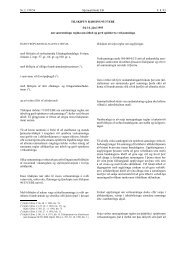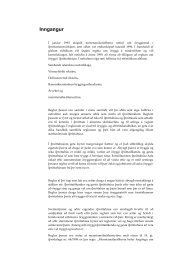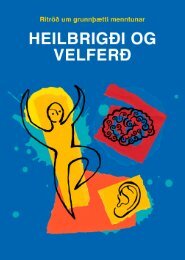Arts and Cultural Education in Iceland : Professor Anne Bamford
Arts and Cultural Education in Iceland : Professor Anne Bamford
Arts and Cultural Education in Iceland : Professor Anne Bamford
You also want an ePaper? Increase the reach of your titles
YUMPU automatically turns print PDFs into web optimized ePapers that Google loves.
In 2007/08 season, there were 78 professional theatre productions. The total audience for<br />
the season was 275,207 people. This figure is equivalent to 1/3 of the entire population of<br />
Icel<strong>and</strong> attend<strong>in</strong>g. While a larger number of amateur productions occurred <strong>in</strong> the same period<br />
(457) these were far more about <strong>in</strong>volvement than audience with only 29,669 people attend<strong>in</strong>g<br />
these performances. Interest<strong>in</strong>gly, 81 of the amateur productions were by children. Dur<strong>in</strong>g this<br />
same period, there were 10 professional dance productions, but a break down of audiences of<br />
dance is not available. Dur<strong>in</strong>g this period, only 3 theatre groups reported that they had toured<br />
abroad but they claimed a relatively high audience reach with nearly 25,000 reported. 27<br />
In 2002 there were just fewer than 200 exhibitions by visual artists <strong>in</strong> Icel<strong>and</strong>. Of these,<br />
around 1/3 of the exhibitions were abroad. If these figures are compared to 10 years earlier,<br />
there were 320 exhibitions, with 150 (or just under 1/2) of all the exhibitions be<strong>in</strong>g taken<br />
abroad. This <strong>in</strong>dicates a decl<strong>in</strong><strong>in</strong>g picture for visual arts. 28<br />
None of the top 10 DVDs <strong>in</strong> Icel<strong>and</strong> for 2006 were Icel<strong>and</strong>ic <strong>in</strong> orig<strong>in</strong>, with all the top 10<br />
com<strong>in</strong>g from the USA. The picture is slightly better <strong>in</strong> film with one of the top ten movies shown<br />
<strong>in</strong> c<strong>in</strong>emas com<strong>in</strong>g from Icel<strong>and</strong>, while once aga<strong>in</strong>, 8 out of the top ten movies were from the<br />
USA. 29<br />
While there are creative success stories <strong>in</strong> Icel<strong>and</strong>, the explicit connection between high<br />
quality arts education <strong>and</strong> economic <strong>and</strong> commercial developments have not been effectively<br />
articulated or communicated, by bus<strong>in</strong>ess, education or culture. Icel<strong>and</strong> has one of Europe’s<br />
lowest levels of students <strong>in</strong> the arts <strong>in</strong> higher education (only 2.6 %) not count<strong>in</strong>g those that<br />
study abroad. 30 This is only around 1/3 of the percentage of students <strong>in</strong> the arts <strong>in</strong> the UK. There<br />
is a real bottleneck. It is difficult to get entrance <strong>in</strong>to further education <strong>in</strong> the arts <strong>in</strong> Icel<strong>and</strong> with<br />
many hav<strong>in</strong>g to seek education <strong>in</strong> the arts abroad It is particularly hard for people <strong>in</strong> small<br />
towns; “Many of our good students end up go<strong>in</strong>g overseas <strong>and</strong> may or may not come back to<br />
Icel<strong>and</strong>. Most people tend to come back, but only when their own children are school aged.”<br />
Despite the lack of places <strong>in</strong> higher education for the creative <strong>in</strong>dustries, members of the<br />
creative <strong>and</strong> cultural <strong>in</strong>dustries <strong>in</strong> Icel<strong>and</strong> are highly qualified. For example, 54% of cultural<br />
workers <strong>in</strong> Icel<strong>and</strong> have higher education qualification (compared to 28% for the overall<br />
workforce). However Icel<strong>and</strong> has the highest % of cultural workers need<strong>in</strong>g to hold a second job<br />
(18.2% compared to a European average of 6.7%). 31<br />
A law was passed 10 years ago (1999) stat<strong>in</strong>g that upper secondary schools should have<br />
departments of arts <strong>and</strong> design. This has improved the situation for tra<strong>in</strong><strong>in</strong>g the potential<br />
creative <strong>in</strong>dustry workforce. Design for example has come to be because of this law – <strong>in</strong><br />
addition to textile <strong>and</strong> craft that had dom<strong>in</strong>ated before. Thus – it was argued <strong>in</strong> a creative<br />
<strong>in</strong>dustry focus group – it is not a co<strong>in</strong>cidence that Icel<strong>and</strong>ic Design is now flourish<strong>in</strong>g. While<br />
many of the creative <strong>in</strong>dustry members felt that there was more <strong>and</strong> better quality arts<br />
education <strong>in</strong> schools <strong>in</strong> recent years, others were critical of what was taught:<br />
What my children are study<strong>in</strong>g <strong>in</strong> the compulsory schools is <strong>in</strong> my op<strong>in</strong>ion not art.<br />
The situation is not good... textile <strong>and</strong> wood work (perhaps ceramics) is taught.... What is be<strong>in</strong>g done is<br />
more crafts <strong>and</strong> skills teach<strong>in</strong>g, not design... In general, the quality depends on the teacher...<br />
27 http://www.statice.is/Statistics/Culture/<strong>Arts</strong><br />
28 http://www.statice.is/Statistics/Culture/<strong>Arts</strong><br />
29 http://www.statice.is/Statistics/Culture/C<strong>in</strong>emas<br />
30 Eurostat cultural statistics 2007<br />
31 ibid.<br />
98




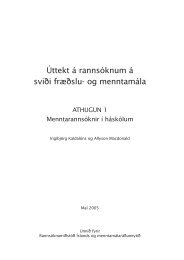

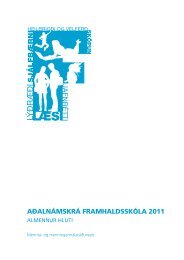
![Aðalnámskrá tónlistarskóla : rytmÃsk tónlist [Eingöngu á rafrænu formi]](https://img.yumpu.com/50843672/1/184x260/aaalnamskra-tanlistarskala-rytma-sk-tanlist-eingangu-a-rafranu-formi.jpg?quality=85)



